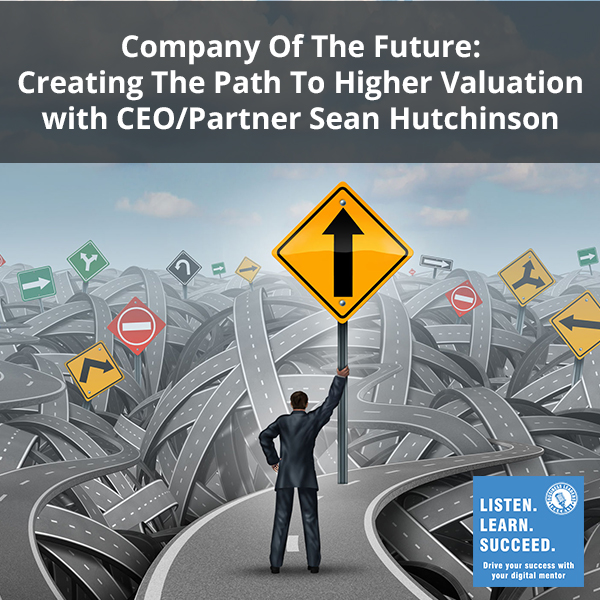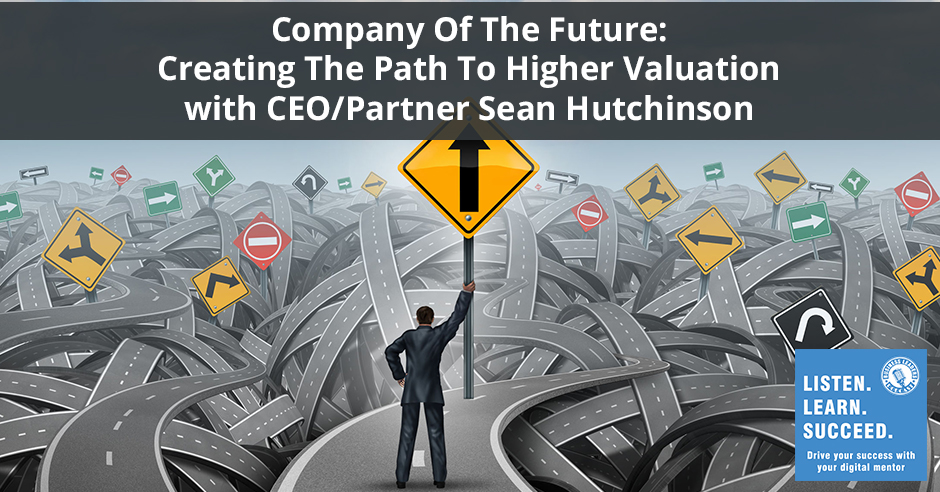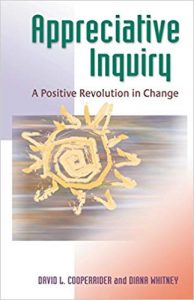Company Of The Future: Creating The Path To Higher Valuation with CEO/Partner Sean Hutchinson


Business is all about being able to look forward and come through from where you are in the present. Sean Hutchinson, CEO/Partner of SVA Value Accelerators, talks about the Company of the Future in the value accelerator. He shares the intensive work his company has been doing with pivoting owners to advance towards their goals in the future. The Company of the Future is that strategy where you will have to think of the current and future state of your business. Get down into it as you answer the question of “Where are we going and how are we going to get there?” Sean breaks down the two tools that can help you find the answers to these questions: the graphics game plan and strategic doing.
—
Company Of The Future: Creating The Path To Higher Valuation with CEO/Partner Sean Hutchinson
We’re going to go through and do a continuation or a deep dive from an original episode with Sean Hutchinson of SVA. He’s the CEO and partner. What we’re going to be talking about is the value accelerator methodology, Company of the Future. Sean, welcome to the podcast.
Thank you, Bob. It’s good to be here.
Let’s talk about the Company of the Future component.
As a reminder, a few principles from the first episode that we did. We have three classes of owners, three categories. We’ve got the explorers, we’ve got the pivoters and we’ve got the triggers. Explorers are seeking information and insights. Pivoters are working on value accelerator actively and intensively. Then the triggerers are owners who are looking in the short-term to transition ownership of their business.
Company of the Future is in the value accelerator. We’re working with the pivoting owners. Company of the Future is a strategy. Think about the current state, future state when you’re doing strategy, you’ve got two questions to answer. They’re simple questions. Where are we going and how are we going to get there? That’s all you need to answer. We created Company of the Future as a 90-day sprint and what we ask our clients to do is concentrate on those two questions.
They’re going to continue to run their business, it’s not like we’re going on a 90-day retreat. What we are focusing on in terms of value acceleration is where are we going as a company out of all the options out there? Where do we want to plant our flag? How do we want to create a direct path or at least a path that can efficiently get us there? Then what resources are we going to need both in our company and from outside of our company in order to activate that pathway?
What I’m going to describe to you are two things after using a few visuals here. I’m going to describe to you two tools. One is the graphic game plan and the other is called strategic doing, which is an agile strategy methodology. We believe in agile strategy and, I want to say as many times as I possibly can, this has a strong bias for action. The reason that we call it strategic doing is because strategic planning doesn’t encourage anybody to do anything at all except plan. Think about being in an action mindset throughout this entire process. That’s what’s going to count.
You’re going to have to learn what the essence of leadership is and that is knowing what not to do.
I want you to imagine that we have a picture from the Kepler Space Telescope that shows us all of the Milky Way at one time. What is that going to look like? It’s going to look busy. That’s the marketplace. When you’re looking at your universe of options, the marketplace is noisy. It has a lot of things flying at you, a lot of motion, a lot of dynamism. It’s hard to pick a spot that looks good. The first thing you’re going to have to do is chaos reduction. You’re going to have to learn what the essence of leadership is and that is knowing what not to do, deciding what not to do. If you’re thinking about the marketplace as a noisy, chaotic, dynamic place like the universe, the first thing you’re going to have to do is clear the windshield a little bit. Try to determine internally why that point in the universe that you want to go to is the right one for your business.
 Appreciative Inquiry: A Positive Revolution in Change
Appreciative Inquiry: A Positive Revolution in Change
There are lots of discussions that have to go into that. What matters to your business? What is your bullseye? If you imagined goal setting as a bullseye with one goal in the center, secondary goals around it, some fringe goals around that. At the end of the day, in order to get your team and all of your company focused on one thing, you need something in that bullseye in the center circle that matters, that gets people excited. We call that the framing question. That goal is going to come out of the framing question and this comes out of something called Appreciative Inquiry, which was developed by David Cooperrider. His book is called Appreciative Inquiry. The framing question is a compelling question. It’s meant to attract the best resources to the table internally and externally.
All of those resources bring assets which are going to be useful in doing and achieving these strategic goals. The framing question goes something like “imagine that our company was able to X, Y and Z in the next five years. What would that look like?” Now we’ve begun to make the process of strategic planning and strategic doing visual. What would that look like? What would this company look like? What would the lives of the people who work here look like? How might it alter the community that we’re in? What does that do to our world? If that framing question is put well, if it’s designed well, resources are attracted to it. That’s the value of appreciative inquiry. If it is not put well, if the framing question is dead in the water, not compelling, it repels resources, so you can’t bring the assets that you need to the table.
Company of the Future, first step, imagine the universe, and then pick something that you’re going to plant your flag on and understand the reasons why. The second thing you have to do is begin to create what we call escape velocity. Let’s imagine that you’re in the space shuttle. There’s some science that’s got to go into this and that’s the planning portion of it. You’re going to need to gather data. You need to understand how many times you’ve got to go around the Earth and when you’re going to exit the Earth’s atmosphere in order to propel you towards that goal that you have out there. We all know what happens in a low earth orbit. How much friction is there? It can pull you down if you’re not flying at the right speed. We want to do in escape velocity is propel ourselves at the right point, at the right speed, with the right resources into a lower friction environment and ultimately when we get into space, we have a no friction environment. It takes a lot of fuel to get us out there but once we’re there, because that space is basically our space now, we’ve claimed it, we are now in our niche. It doesn’t take very much energy for us to alter course.
Now we can be agile because we’re in the right place, at the right time for the right reasons. Those are the kinds of metaphors. Those are the visuals that we could use with the client. Chaos reduction, get the noise out of the way, understand where you’re going, and understand how you’re going to get there. Two easy strategy questions that are impossible to answer. No, I’m kidding. You can. Company of the Future uses two tools. The graphic game plan which is divided into three parts. One, that target that we talked about and the hardest part of that is picking a clear, concise, primary goal. Most companies, when you ask them about their strategic goals, they’ll give you a laundry list, “We want you to do this. We want you to do that.” In a lot of cases, it’s in a language that nobody finds clear or compelling because it’s not.
Be able to align your team around one thing that they literally could put above their computers or on a coffee cup and remind themselves every day that that is our primary goal. My contention has always been, not facetiously by the way, that if it doesn’t fit on a coffee cup, then it’s not a good goal. Everybody’s got to be able to identify with it and quote it offhand. Once you get that established, you can then look at the secondary goals and the third goals but here’s where the action starts to come into play.
Now you must begin to build your resources with assets from four classes. Knowledge, social or networks,, financial assets, capital of various kinds, cash, sometimes intellectual property, and finally physical assets that could be, in the manufacturing world for instance, additional manufacturing capacity that already exists but is not being used.
In collaborative environments in this planning that if you think of it as a community ecosystem of assets, you might have two manufacturers. Even if they’re competitors, it’s better for the community if they share machines when they have excess capacity rather than having one buy a $50,000 machine that they don’t use all the time and the other one buying a $50,000 machine that they don’t use all the time. Both companies are now decapitalized and they’re still not using the resources efficiently. Those kinds of assets emerge as a result of a good framing question that attracts resources and support.
Then we’re going to look at success factors. What are those things that must be present in order for you to reach your primary goal, but in and of themselves do not guarantee success? With those, we’re going to expose risk factors. What are the risks? What would get in the way of us not being able to get there? Ultimately, we’ll develop what we call pathfinder projects? I love Pathfinder projects because it brings teams together and it lets them work together on something that moves the needle quickly toward achievement of their goals, usually within a 90-day framework.
What would be an example of a pathfinder project?
Let’s say that the primary goal, to make things simple, is that we want to go from being a $5 million company to a $10 million company in the next eighteen months. That’s what we put in the box that’s in the center circle of the target. We can say, “How does that break down?” We’ve got a division that’s doing one million and we think it could do two. That’s great, but how do we get from one to two? The chances are good that that might break down into three pathfinder projects which might be done in sequences. Bring the team into the room and say, “Let’s identify the paths. Let’s identify the things that we would call pathfinder projects. Let’s break it up into teams. Team one, you guys are going to work on pathfinder project one and this needs to be done in the next 90 days.” There’s a parallel pathfinder project #2, but all of these projects are not meant to work on issues or opportunities unless it’s moving us toward the goal of taking that division from $1 million to $2 million in revenue for all the right reasons that we’ve already articulated through our framing question and the identification of success factors and risks. To borrow from our Decision Dynamics podcast we did earlier, we are figuring out what matters, making better decisions faster, and acting with grace and accountability – all together.
If it doesn’t fit on a coffee cup, then it’s not a good goal.
In our first podcast episode, we talked about the seductiveness of moving the top line and introducing risk in the process, which destroys value in the company. If you’re going to add customers, if you need to go out and find new customers in order to move from one to two million in this case, that could be a pathfinder project. Identifying and beginning to put your message in front of 100 new customers. There’s a concept that is worth putting on the table here. We refer to it as “the next right customer.” If you’re trying to move from $1 million to $2 million and you dig down a bit further, you actually need to move from $1 million to $2 million and maintain an 18% gross profit margin and not have to make any huge capital investments along the way. That pathfinder project has to take into account all of those design constraints and work them into the plan. The pathfinder team starts working on that and they have a very clear mandate about figuring out how to do itin 90-days. We’re going to meet every 30 days to make sure that we’re on goal and to figure out what we will do in the next 30 days. What did we accomplish in the last 30, and what will we accomplish in the next 30. That’s called the 30/30 in agile strategy. That’s part of what we’re trying to embed in the organization when we’re doing Company in the Future.
“Where are we going?” is chaos reduction, picking in some place to plant your flag, understanding the reasons why, and then estimating the resources that are going to be necessary. Do you have enough on this spaceship to get you there, given all the twists and turns that you’re most likely going to have to take? How are you going to manage that twisting pathway? You’re going to do it through an agile strategy and agile strategy is a lot of things. I can’t go into it all, but I want folks to think about 90-day cycles of planning and doing. If you draw a straight line from left to right and you think about the old versions of strategic planning versus implementing a strategic plan, it looks a lot like this. If planning is above that line, it’s a plan and then we finally get to the end of planning. We dropped down under the line and we do, we implement. Then sometime down the line after about a year or two of doing that, we’re going to go back up. We’re going to revisit the strategic plan and lo and behold, nothing adds up to what we thought it was going to add up to. In agile strategy, we’re going to do something different.
Imagine the horizontal line again. We’re going to plan and then we’re going to do and then we’re going to plan and then we’re going to do. It’s like a sine wave and it’s a 90-day cycle. Within that 90 days, we use the 30/30 process. Accountability is very simple in our minds. The whole team comes together every 30 days and they say, “Here’s what we promised to do in the last 30. How much did we get done and what are we going to do in the next 30?” and then they meet again and the next 30 becomes the past 30 right on down the line. Once that discipline is in the company, and can’t be escaped because it’s so embedded as a way of doing business, I can guarantee you that if your competitors are doing it the old way, you will rocket past them at a speed that you can imagine. They will never catch you because you have a way of adjusting your strategic path in real-time.
 Company Of The Future: Planning does not appeal to people who are in the trenches getting work done.
Company Of The Future: Planning does not appeal to people who are in the trenches getting work done.
Most companies suffer from strategic planning. It’s something that people hate. They think about going to the strategic planning retreat or strategic planning itself. Planning does not appeal to people who are in the trenches getting work done, so we need to combine the two. We need a hybrid of planning and doing, which is why agile strategy is so important. Our process is not something that we invented. It came out of Purdue University’s agile strategy lab and it was created by a group of people, believe it or not, who were involved in economic development. What they were trying to do is figure out how to bring together a complex ecosystem of stakeholders. Think about a community trying to do strategy and implementation, move the needle on jobs and all those things that matter to the vitality of the community.
You have a very complex ecosystem of stakeholders with many competing agendas, civic, business, the citizens themselves, and lots of different ways of judging success. It becomes problematic. By gathering the resources, pathfinder projects, setting clear goals that everybody can understand including the one right in the middle of the bullseye, then doing 30/30 on that sine wave, whole communities can move in concert. They’ve done it well in part because assets are being contributed from a lot of different sources (knowledge, social, financial, physical). Now, take that and move it over into the business.
In smaller privately held businesses where resources are so precious, you can get that 30/30 meeting done, which is essentially an accountability meeting. Promises made, promises kept. “What are we going to do next? What help do we need to do it? Team B we need you over in team A to help out.” There is no finger pointing in the system if you didn’t meet your promises of the last 30 days. It’s, “We didn’t get it done, but what are we going to do in the next 30 to catch up and keep this moving? If we need to reposition teams or put two together to help, then that’s what we’re going to do.”
Let’s say you’ve got a 90-day period and it takes you 120 days to get it done.
It’s okay. That’s a lot faster than it was most likely. If the timeline slips 90 versus 120. I’m not concerned about that. What I’m concerned about is clarity of vision, the understanding of why you’re there and where you’re going. Then having a process in place so that no matter who in the company comes or goes, you’re not person independent, you’re process dependent. When we work with our clients on this, remember we’re not starting with a blank sheet of paper. There are a lot of habits that have been ingrained in the organization, good and bad.. A lot of the skepticism around strategy and planning is because somebody wrote a big document and then never looked at it again. Whatever failures there may have been have created resistance in the organization.
Failures create resistance.
We’re trying to put in place a system, a process, a way of thinking, a set of behaviors that add up to a culture of planning and doing in a hybrid short cycle. Sounds easy, sounds nice, but the first thing you have to do is break a lot of old habits. Break through some walls of skepticism and mistrust and the dismissal of that strategy planning that’s never worked well. I don’t blame them. I can’t blame those people because let’s face it probably it didn’t work so all they’re doing is telling the truth and, in our world, the truth is enough. The Company of the Future, what I love about it is that it gives businesses owners, teams, stakeholders, let’s call them all stakeholders, a way to see the future, a way to get to the future and a way to adapt because we know that the path is never straight.
We have clients in Puerto Rico and I can tell you the story of Puerto Rico leading up to Maria, and Puerto Rico after Maria. I can’t possibly share how difficult, how impactful that event was, until you see it but what happened with those companies with agile strategy and a way of managing the path and clarity of vision, no matter what, was that they didn’t have to change the vision for the company. They just had to adapt the pathway to get there. The hurricane was a huge impact and it was a massive obstacle, but it wasn’t impossible to navigate. We have seen some of our clients thrive as a result of it. You almost hate to say it because it was such a horrible event. People died. People are still living under blue tarps down there. It’s not pleasant. On the other hand, on the business side, all of the things that our clients are doing are helping to restore the community that they love. We move in the direction of our conversations. The conversation in agile strategy is always forward, never backward, and that’s the power of the program.
Company of the Future is a 90-day sprint and it’s building on the sprints that happened before it. As a result of Company of the Future, we have another skill set, another process that the company has now adopted. They’re learning how to use it. It won’t be perfect. In some cases, it will be messy, but then we’re able to move into the next sprint that follows, which is going to be productivity. Without clarity and without the process of agile strategy, productivity is a hard thing to get and keep. That’s Company in the Future.
It’s not what you say, it’s what you do and so much of this is doing. We will take and conclude this component or portion of the deep dive and reconvene on the next one. Thanks, Sean.
Links Mentioned:
About Sean Hutchinson

We share a bond. I’ve founded five companies, all of them with partners, some more successful than others. I’ve led a fast-growing global company as a very green, but hard-working and quick-learning, 34-year-old who everyday had to make big decisions with big implications. It became the largest firm of its kind in the world. And, maybe most importantly in this case, I’m the 3rd Generation heir to my family’s 62-year-old custom millwork manufacturing business. I’ve sat in your chair many times and I love being an entrepreneur.
As one of the three founders of SVA, my role is once again to fulfill the responsibilities of the Chief Executive Officer. I focus on strategy and growth – in other words, our Company of the Future. And that’s where I help our clients too – working with owners and their leadership teams to imagine what could be, can be, and will be their Company of the Future. I see my work as transformational, not just transactional. It’s all about getting you “Ready for Next.”
Over the years, in order to serve our clients better, I’ve invested heavily in education. In addition to my Masters degree from Miami University of Ohio, I am a Certified Exit Planning Advisor (CEPA), Certified Merger and Acquisition Advisor (CMAA), and I hold the FINRA Series 79 and 63 securities licenses. I serve on the Board of Directors for three private companies, including my family’s business. I speak frequently to owners and professional advisors across the USA.
Love the show? Subscribe, rate, review, and share!
Join the Business Leaders Podcast Community today:
- businessleaderspodcast.com
- Business Leaders Facebook
- Business Leaders Twitter
- Business Leader LinkedIn
- Business Leaders YouTube
The post Company Of The Future: Creating The Path To Higher Valuation with CEO/Partner Sean Hutchinson appeared first on My podcast website.